MB&F HM5 On The Road Again – Seventies Retro Inspired Horological Machine 5
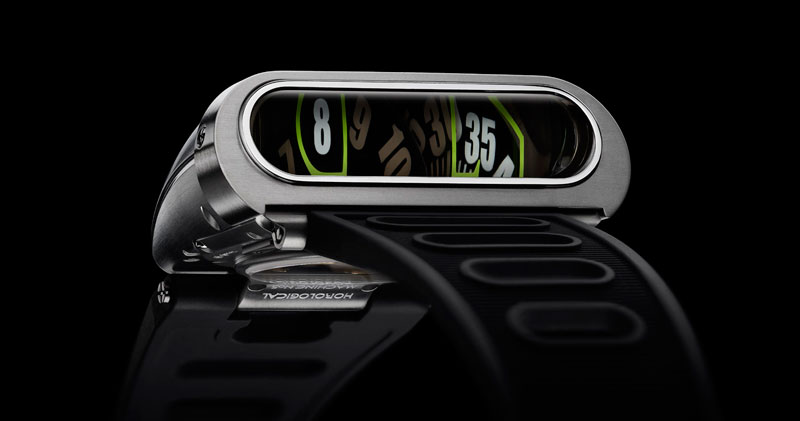
It’s been just 5 years since MB&F launched its first timepiece, Horological Machine 1 (HM1), and since than we’ve seen new Horological Machines each year, until HM4 Thunderbolt was presented in 2010. In 2011 an entirely new collection, featuring the Legacy Machine 1, saw the light of day. Today MB&F launch their new, fifth, Horological Machine, called HM5 On the Road Again.
Like all Horological Machines its design is FAR from the ordinary and always offers a strong visual analogy with the source of inspiration. HM5 is no different in that perspective, as takes its cues from futuristic-looking icons of the 1970’s.

This text was in MB&F’s press release and something triggered me:
You could say HM5 is the epitome of the 70’s – a time when everything seemed possible: space exploration, supersonic flight, hovercrafts, jet packs, the first supercars like the Lamborghini Miura… In watchmaking, quartz and LED displays prepared to wipe out traditional mechanical movements. And if you asked someone back then, what watches would look like in the year 2012, the answer was certainly not “round, white dials, hour and minute hands” like most watches remain today.
Of course, that last statement about watches with “round, white dials, hour and minute hands” is painfully but oh so true. However what also triggered me was the mention of the Lamborghini Miura, one of the first super cars with a futuristic design. And of course I wondered why this particular car is mentioned. Well, first take a look at the Miura’s back and keep the louvres that cover the rear window in mind…
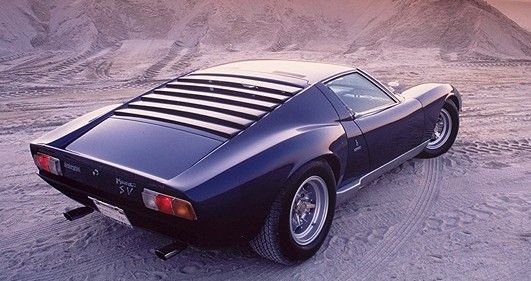
The purpose of the louvres on these awe-inspiring cars was to restrict sunlight (and heat) from entering the near horizontal rear window. The functional louvres on HM5 do the opposite in that they open to allow light down onto the Super-LumiNova numbers on the hours and minutes indication disks to charge them. The disks are actually flat on top of the movement (under the louvres), not vertically at the front of the case where they appear to be thanks to some optical magic. Opening and closing the louvres also changes the dial’s light intensity. The louvres are opened and closed by a slide set into the right side of the case.
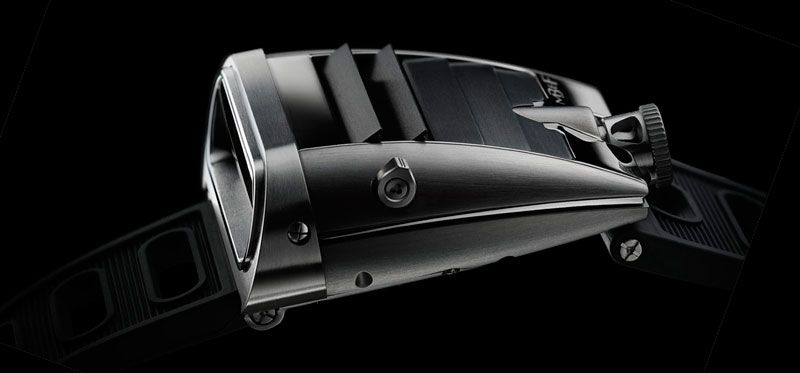
Another distinguishing feature of supercars are large dual exhaust pipes that are usually seen accompanied by a roar of engine noise and smoking rubber. But HM5’s exhausts are not there to expel combustion gases in a throaty roar, but to drain water in case HM5 gets wet.
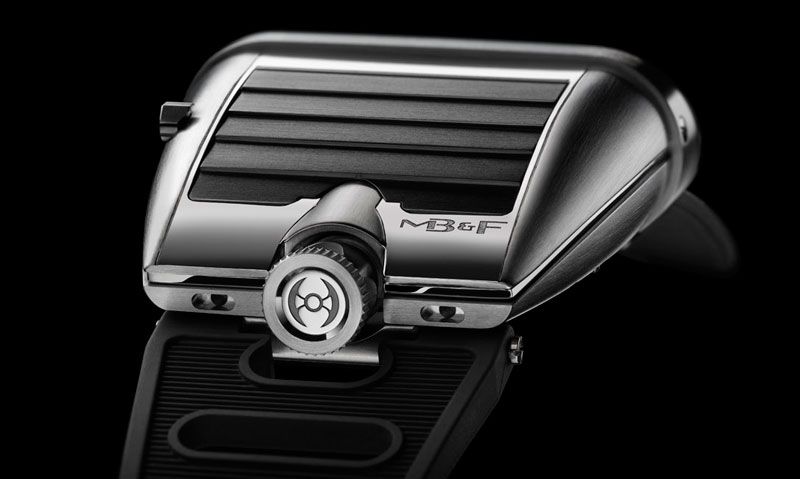
Yes, in case the HM5 gets wet. That’s because the case of HM5 is not water resistant, but its movement is. The movement is held in a container, that fits inside the outer case. Those supercar louvres let in water as well as light − the reason for those dual exhaust ports – so to protect the movement from moisture as well as shocks, it is housed in its own stainless steel shell.

Jean-François Mojon, who was also responsible the gorgeous movement of Legacy Machine 1, and Vincent Boucard developed the HM5 Engine/complication. It may appear simple, but it’s complicated!
HM5’s movement features the well-known 22k gold battle-axe shaped ‘mystery’ winding rotor. Like all mechanical dream machines from Max Busser and his Friends, the movement features stunning hand-finished bridges. The automatic movement is based on a gear train from Sowind, which is the owner of Girard-Perregaux, delivering 42 hours of power reserve and beating at a rhythm of 28,800 vibrations per hour.
The jumping hours are bi-directional, enabling the time to be easily set both forwards and backwards. The two mineral glass disks of the hours and minutes are supported by a flat wide bridge. The disks overlap as much as possible to maximise their diameter and space for large legible numerals.

The disks rotate flat on top of the movement and yet we see the time indications vertically in a ‘dashboard’ at the front of the case. To achieve this, a sapphire crystal reflective prism was developed, which bents light from the disks 90° as well as magnifying it by 20% to maximize legibility.
Because the time is reflected, the numbers are printed on the disks as mirror images (see photo above), so that they display correctly on the ‘dial’. The glass on the front is not black but dark-tinted so that it is possible to see time arriving and departing and the numbers have an light-green outline, reminiscent of the glowing instruments of a supercar on a high-speed road trip at night.
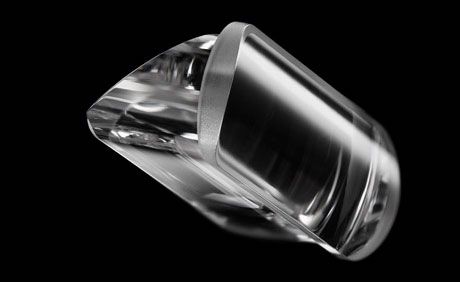
The sapphire prism is wedge-shaped has angles which are precisely calculated, to reflected the light from the horizontal indications to the vertical. A convex lens at the front provides the magnification. Much effort was spent to develop and produce crystals that reflected and bent light without the slightest distortion.
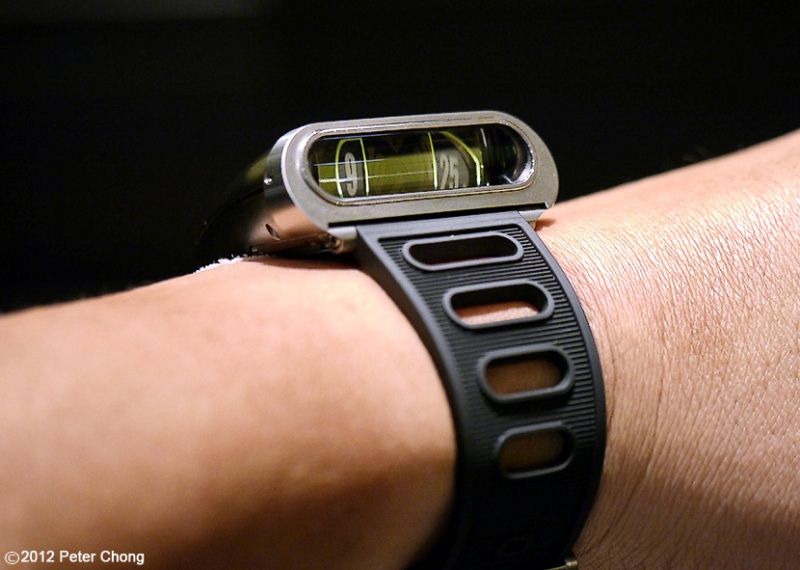
The zirconium case with internal water resistant steel engine container, features a slide button to open/close the louvres, exhaust ports to drain water and measures 51.5mm by 49mm and 22.5mm in height. Not the smallest timepiece, however in the seventies watches weren’t exactly small either. For more “live” photos, you can visit Peter Chong’s blog here.
The HM5 is released as a limited edition of 66 pieces in zirconium and comes at a price of CHF 54,000 + tax. You can find more technical details and information about availability on the MB&F website.
This article is written by Frank Geelen, executive editor for Monochrome Watches.



